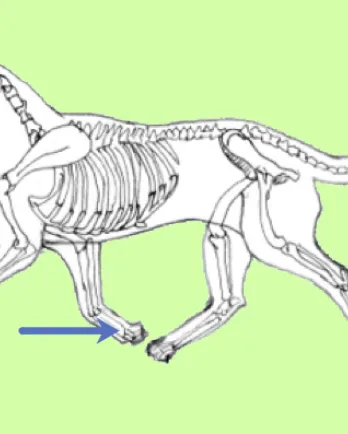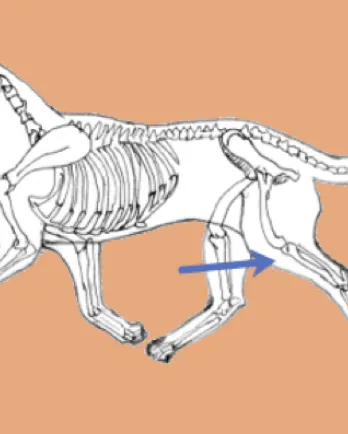Three Easy Gentle Techniques for Livening Up Your Old Friend
Editor's Note: This is a guest post on the Grey Matters Blog and not written by anyone affiliated with Grey Muzzle. We allow guest contributors from time to time in order to provide our supporters with a wide range of topics pertaining to senior dogs.
One of the most heartfelt parts of my work is helping owners make their way through the aging process of their geriatric dogs. There are many gentle therapies we can provide to make them more comfortable, strengthen weak limbs, and help guide the process of aging instead of reacting to it. A well-intentioned touch goes a long way towards creating comfort and vitality. An open heart for your grey muzzled dog is icing on the cake. With a little navigation you can enrich both your old dogs’ lives and your own as you gently create harmony in their aging bodies.
Using these simple acupressure and neuro-lymphatic techniques can help open up a stiff spine and reduce pain while having profound effects on the animal’s mental, emotional, and physical well-being. I love to teach owners these techniques, since they often take away the fear and heart pain associated with the aging of their canine friends. They also facilitate a deep, loving, and nurturing time that is very special. And these techniques are fast, extremely effective, easy, and safe!
Before you begin, I encourage you to consult with your veterinarian if your dog is ill or injured. These points are designed to “do no harm,” however, please keep the following disclaimer in mind: These sessions are not a substitute for veterinary medicine and are not intended to diagnose or to treat diseases. Be sure to consult your veterinarian if you suspect a health problem or prior to the use of acupressure if your dog has any serious health problem. Lastly, these techniques should not be used on dogs who are pregnant.
A Few Tips for Successful Sessions
Prep for you:
- Be present.
- Be calm.
- Take three deep breaths
- Open your heart and smile!
Prep for your old friend:
- Is your dog in a calm, relaxed state? Chances are good that if you are calm, your friend will be too. Creating a calm relaxed atmosphere is key.
Find the Acupressure Points: Download and print these three sheets (4 Easy Acupressure Points, Good Morning Spinal Wakeup, and Kidney Belt) for handy instructions. These points do not need to be exact; if you are unsure of the location just open up your scope of touch to include a larger area and the dog’s body and Qi (electrical energy) will respond accordingly.
In Traditional Chinese Medicine it is poetically said that the points are often found in the valleys not on the mountains. Translated, this means that you will most often find them in hollows and will feel a little divot where the point is.
Point pressure, technique, and response: Gently stroke the general areas in the direction of the hair, then once you find the “divot” (acupoint) take one or two fingers and with gentle, soft pressure, sink in and hold the point for 10-60 seconds. The smaller your dog is the lighter the pressure you should use, akin to touching your eyelid. This pressure activates and moves the Qi in the body. When you feel you are done, gently release the pressure and stroke the area with a soft, flat hand or fingers. Enjoy observing your dogs’ response to your touch. Watch/listen to your dog’s responses and adjust accordingly. Too little may tickle, too deep may be tender. This is a dynamic part of deeply “connecting” with your animal. The animal may sigh or yawn or stretch or sneeze, this is all normal and a release of endorphins in the body. Good work!
Be sure to breathe. The animal will be on alert if you are holding your breath. And remember, your breath will also help move your Qi.
Let’s get started!
TECHNIQUE #1
Good Morning Spinal Wake-up
I like to do the Good Morning Spinal Wake-up first thing in the morning and/or before the other two techniques below. This technique literally “wakes up” three important systems. It stimulates the neuro-lymphatic points along the spine and gets the lymph fluid moving after a night’s rest. It also wakes up the “Shu” acupressure points along the spine that connect with every acupuncture meridian and the nerves to every organ in the body. These Shu points are like circuit breaker switches that turn everything on. Lastly, it brings blood flow into the muscles that surround the spinal column which helps with flexibility and pain. This is great for dogs of all ages, but especially for geriatric dogs and dogs in recovery.
This technique is best done first thing in the morning when the dog is standing or sitting. This technique starts a big but gentle cascade of circulation amongst these three systems and only takes 30-45 seconds! My dogs line up for it every morning!
How to do the Good Morning Spinal Wakeup:
Begin just behind the shoulder blades.
Hold your thumb and forefinger 1 to 2 inches apart and position each finger along opposite sides of the spine. The size of your dog will determine the width of your fingers.
Sink in with gentle pressure and while in place, wiggle your fingers front to back. Next, slide back approximately 1 inch (less for small dogs) and you will naturally fall into a little divot between the sides of the vertebrae.
Wiggle a few times again and slide back and repeat until you reach the pelvis area where you will not feel any more vertebrae.
Repeat 3-4 times and watch your dog limber up and smile!
TECHNIQUE #2
Four Easy Acupressure Points for Comfort and Wellness
These four points create a synergistic effect that addresses discomfort and enhances overall well-being. They are simple to find, safe to use, and diverse in addressing disharmony in your old dog’s body. Rub with joy!
Large Intestine 4 (LI-4) “Joining Valley” – Master point for the head, neck, mouth, jaw, and GI tract.
This point on humans is often called “the headache point.” It is a potent pain reliever and can relieve pain throughout the body while strengthening the Qi in the head, neck and gastrointestinal tract. It is an “elimination point” for the gastrointestinal tract so if your dog has any problems with diarrhea it should not be used. It is located on the inside of both front legs at the dew claw (thumb) which is below the dog's “wrist” and above the paw.
Bladder 40 (BL-40) “Entrusting Valley” – Master Point for the spine, back, and hind legs.
This point is very effective when used regularly for strengthening weak hind ends and is great when combined with both the Good Morning Spinal Wake-up and the Kidney Belt (see below). It is located on the backside of the hind legs where the hamstring muscle meets the back of the leg. This is approximately the same height as the dog’s stifle (commonly thought of as the knee). BL-40 will have a very distinct divot particularly when the animal has a weak hind end.
Bladder 60 (BL-60) “Kunlun Mountain” - Aspirin Point, strengthens back, releases sinews.
This point is extremely effective for overall pain when combined with LI-4. This combo has a synergistic effect that encompasses full body pain and helps strengthen weak hind ends. It is not a replacement for pain medications but can be an effective ally for widespread musculoskeletal pain. It is located on the outside of both hind legs in the groove or divot of the hock joint. This point can be very tender so start with a gentle touch and watch/listen to your dog’s response.
Stomach 36 (ST-36) “Foot Three Mile” - Master Point for the Gastrointestinal Tract, Strengthens energy, Qi, immune system and more!
I like to think of this point as the “everything point.” It is like salt when you are cooking, it enhances flavor and mixes well with almost everything. When we need a balancing point for all the flavors of the body’s needs, we throw this in. This metaphor also stretches to the fact of being a Master Point for the GI tract. When our GI tract is out of balance, all the corresponding organ partners are thrown off kilter.
The name “Foot Three Mile” speaks to the points ability to prompt and boost the body’s natural energy and put a sparkle in the eye of our old ones. The Chinese say this point gives you so much energy that you can walk three miles! It is a good point to finish your acupressure session with as it wakes up our relaxed furry friends. *It can be tender at times, so again, watch/listen to your dog's reaction.
It is located on the hind legs 1/3 of the way down on or near the outside front line of the muscle below the stifle (commonly known as the knee). This is an area where you will want to gently stroke with the hair direction until you find the divot. If you do not find it just rub the front and outside of the muscle and you will trigger the point. Rub with joy!
TECHNIQUE #3
Kidney Belt for Strengthening Low Back and Hind End
This technique covers five acupuncture points and is very effective for strengthening the lower back and hind end.
Gently feel for the last ribs on each side of your dog. It is helpful if your dog is laying or sitting for this technique. They will often choose what is comfortable for them.
Place your hands like a butterfly, directly behind and butting up to the last rib on each side with fingers flat and resting softly on the dog. Do not push or squeeze.
Place your thumbs gently on the spine of the dog.
Take a deep breath and quiet your mind and hold your hands there for several minutes. The dog will do the rest!
Use as often as needed for weak hind ends. Use in conjunction with Good Morning Spinal Wake-up and Four Easy Acupressure points.
These three techniques above can be done together or one at a time throughout the day. Just remember… Breathe, smile and rub with joy!
Your senior dog will thank you!
Guest author Elizabeth Johnson, EEBW, CMFT has been working with the health and wellness of small, large, and exotic animals and wildlife for 35 years. She works from the point of deep clinical understanding, empathy, and compassion to find the "health" of each animal while promoting well-being in the physical, spiritual, and emotional realms of all involved. She is a TEDx speaker, Author, Animal Empath, mentor, and joyful dog lover.
Visit ElizabethAnneJohnson.com for more information or to sign up to receive updates on Elizabeth's upcoming books and latest blogs. You can also connect with Elizabeth on LinkedIn.







